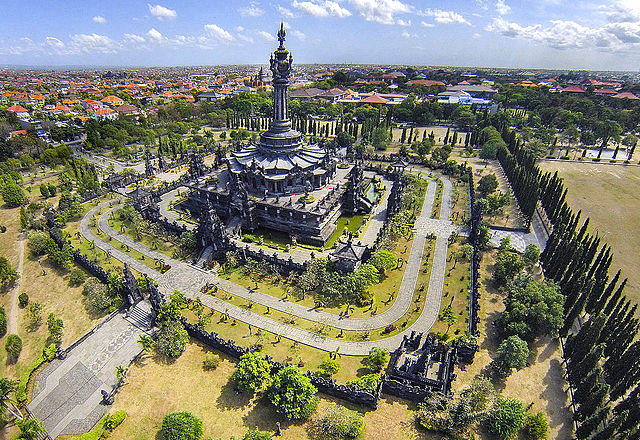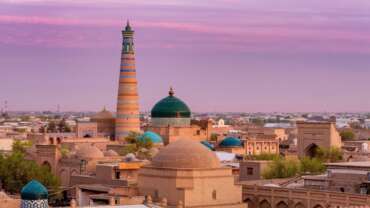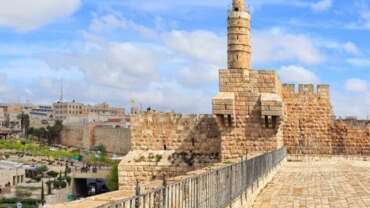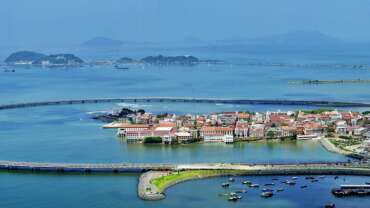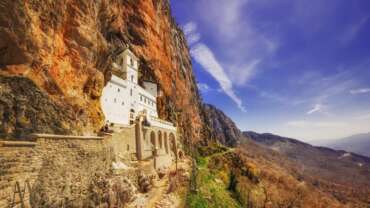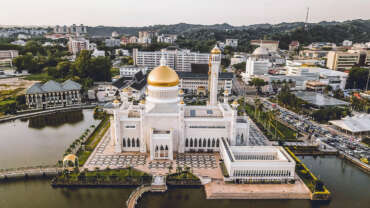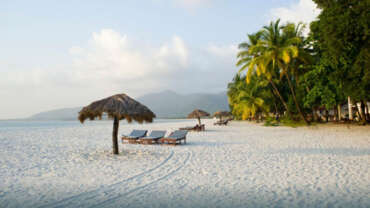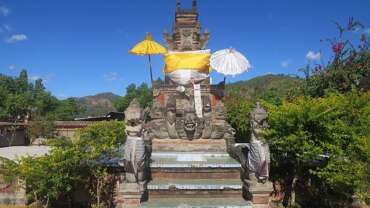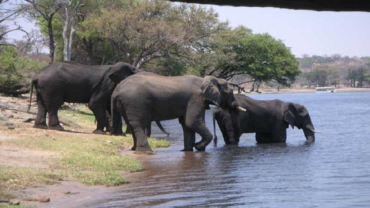Indonesia - Wonderful Indonesia
Indonesia, officially the Republic of Indonesia, is a country in Southeast Asia and Oceania, between the Indian and Pacific oceans. It consists of more than seventeen thousand islands, including Sumatra, Java, Borneo, Sulawesi, and New Guinea.
History of Indonesia
The archipelago: its prehistory and early historical records
Remains of Homo erectus (originally called Pithecanthropus, or Java man) indicate that the ancestors of humans already inhabited the island of Java roughly 1.7 million years ago, when much of the western archipelago was still linked by land bridges. Some 6,000 years ago a rapid postglacial rise in sea level submerged these bridges. What remained was the largest island complex in the world: the Indonesian archipelago.
Not surprisingly, the sea has greatly influenced Indonesian history, and the boat has long been a pervasive metaphor in the arts and the literary and oral traditions of the islands. Monsoon winds, blowing north and south of the Equator, have facilitated communication within the archipelago and with the rest of maritime Asia. In early times timber and spices of Java and the eastern islands were known afar, as were the resins from the exceptionally wet equatorial jungle in the western islands of Sumatra and Borneo. By the first centuries CE, goods were already being shipped overseas, and navigable rivers had brought the Indonesian hinterland into contact with distant markets.
Although records of foreign trade begin only in the early centuries CE, it is possible that people from the Indonesian archipelago were sailing to other parts of Asia much earlier. The Roman historian Pliny the Elder’s Natural History suggests that, in the 1st century CE, Indonesian outriggers were engaged in trade with the east coast of Africa. Indonesian settlements may have existed at that time in Madagascar, an island with distinct Indonesian cultural traits. The geographer Ptolemy, in the following century, incorporated information from Indian merchants in his Guide to Geography concerning “Iabadiou,” presumably referring to Java, and “Malaiou,” which, with its variants, may be a rendition of “Malayu,” a term once broadly applied to various interior regions and kingdoms of Sumatra. (In contemporary usage and spelling, the term Melayu refers to Malay peoples.)
Regular voyages between Indonesia and China did not begin before the 5th century CE. Chinese literature in the 5th and 6th centuries mentions western Indonesian tree produce, including camphor from northern Sumatra. It also refers to two Indonesian resins as “Persian resins from the south ocean,” which suggests that the Indonesian products had been added to the existing seaborne trade in resins from western Asia. It is likely that Indonesian shippers of the time were exploiting southern China’s economic difficulties, incurred as a result of the region’s having been cut off from the ancient trade route of Central Asia. Small estuary kingdoms were beginning to prosper as international entrepôts. Although the locations of these kingdoms are unknown, the commercial prominence of Palembang in the 7th century suggests that the Malays of southeastern Sumatra had been active in the “Persian” trade with southern China.
Easy overseas communication did not, however, result in the formation of territorially large kingdoms. The many estuaries of Sumatra and Borneo, facing the inland seas, possessed an abundance of nutritious seafood that made possible a settled mode of life, and for the people of these estuaries, contact with their neighbours was more important than any connections they could make with overseas lands. Local groups, endowed with more or less comparable resources, were most concerned with protecting their separate identities. Such provincial interests similarly prevailed on the island of Java, where the lava-enriched soil, watered by gently flowing rivers, encouraged wet-rice production and a patchwork pattern of settled areas in the river valleys separated by mountains and jungle.
Long before records began, many of the coastal and riverine groups of the Indonesian archipelago were evolving an elementary form of hierarchy, accompanied by artistic symbols of rank. No single group, however, was large or powerful enough to overrun and occupy neighbouring territories; rather, the various peoples’ energies were absorbed by ever more intensive exploitation of their own natural resources. While those living on or close to the sea knew that geographic isolation was out of the question, they regarded their maritime environment as a means of enhancing their well-being through imports or new skills. Their outward orientation, then, ultimately encouraged the pursuit of local interests rather than inculcating any sense of belonging to a larger community. Indeed, the structure of Indonesian written and oral sources suggests that the origins of kingdoms on the coasts of the Java Sea were associated with the success of local heroes in turning the arrival of foreign trading treasure to their advantage.
Many Indonesian place-names have remained unchanged since the beginning of documented history. In such places, which were often in close proximity to each other, each leader saw himself at the centre of the world that mattered to him, which was not, until later, the archipelago or even a single island but his own strip of coast or river valley. Some centres achieved local hegemony, but never to the extent of extinguishing permanently the pretensions of rival centres. Thus, the early history of Indonesia comprises many regional histories that only gradually intersect with each other.
The historical fragmentation of the archipelago, which was sustained by its rich climate and accentuated (rather than diminished) by easy access to the outside world, is evident in Indonesia’s linguistic diversity. The speakers of Austronesian languages almost certainly drifted into the region in small groups from the Asian mainland or the Pacific Islands over long periods of time. When they reached the coasts and rivers of the archipelago, they did not suddenly assume a common identity. On the contrary, they remained scattered groups, sometimes coexisting with descendants of earlier populations of the Pleistocene Epoch (roughly 1,800,000 to 10,000 years ago), who in their turn had also learned to make economic use of their environment over an immense span of cultural time. The hundreds of languages within the western branch of the Austronesian family (which includes most languages of Indonesia) are an index of the manner in which the peoples of the Indonesian archipelago submitted to the social, economic, and natural realities of their environment.
Stone or metal inscriptions, together with surviving copies of early religious texts, are the most important sources of documentary information. However, because these documents are always concerned with specific places, construction of a comprehensive narrative history of any extensive area is virtually impossible. The reality behind many interregional relationships, then, necessarily remains a riddle. Nevertheless, the ideas of noblemen, as articulated in architecture and literature, reflect varying degrees of exposure to influences from beyond the archipelago. Moreover, they reveal points of intersection in the beliefs and practices of communities throughout the region; all groups maintained basic assumptions concerning the dependence of humans on the goodwill of supernatural entities.
People of Indonesia
Indonesia is situated at the meeting point of two of the world’s population groups, Asians in the west and Melanesians in the east. The great majority of Indonesians are related to the peoples of eastern Asia, although over the centuries there also has been considerable mixing with Arabs, Indians, and Europeans. In the eastern islands, however, most of the people are of Melanesian origin.
The Indonesian national motto, “Bhinneka tunggal ika” (“Unity in diversity”), makes reference to the extraordinary diversity of the Indonesian population that has emerged from the ongoing confluence of peoples, languages, and cultures. The country includes more than 300 different ethnic groups and more than twice as many distinct languages, and most of the major world religions, as well as a wide range of indigenous ones, are practiced there. Notwithstanding this diversity, most of the people are of Malay ancestry, speak Austronesian (Malayo-Polynesian) languages, and profess Islam.
Ethnic groups
The barriers of the mountains and the sea have protected the character and traditions of many groups. Away from the major cities and areas of dense population, there are significant variations from one valley to the next and almost from one village to the next. In many cases the highland groups of the larger islands—Borneo, Sumatra, and Celebes—were relatively untouched by international influences until the arrival of Christian missionaries during the 19th century; these upland peoples continue to reflect great cultural diversity. Each island or group of islands east of Java also has maintained its own distinct character, in many cases strongly influenced by different religions. In particular, Bali—with its long tradition of Hindu and Buddhist influences rooted in local religious practices—is quite different in character and customs from any other part of Indonesia.
Western islands
The diverse ethnic populations of western Indonesia generally may be grouped into three broad categories. These are the inland wet-rice (irrigated rice) societies, the coastal trading, farming, and fishing peoples, and the inland societies of shifting cultivators.
The first group, the historically Hinduized (but now primarily Muslim) wet-rice growers of inland Java, Madura, and Bali, make up nearly three-fifths of the national population. With an ancient culture informed by strong social and agricultural traditions, it includes the Javanese, Sundanese, Madurese, and Balinese peoples.
The Javanese constitute Indonesia’s largest ethnic group, accounting for roughly one-third of the total population. Most Javanese live in the densely settled, irrigated agricultural regions of central and eastern Java—the most populous parts of the country. The cities of Yogyakarta and Surakarta (Solo), in the centre of the island, are strongholds of Javanese culture and maintain traditional rulers, although these leaders have no real political power. Java’s western region, including the city of Bandung, is the homeland of the Sundanese, who are related to but quite distinct from the Javanese in language and tradition. The Sundanese are the second largest ethnic group in Indonesia.
The island of Madura, northeast of Java, is the homeland of the Madurese, Indonesia’s third largest ethnic group. In addition to cultivating wet-rice paddies, many Madurese raise cattle. The Balinese, who live just to the east of Java on Bali, are known for their intricate irrigation systems and terraced rice fields. Of the historically Hinduized communities in Indonesia, the Balinese are the only nonimmigrant practitioners of Hinduism.
The second group, the more strongly Islamized coastal peoples, is ethnically heterogeneous and includes the Malays from Sumatra and, from southern Celebes, the Makassarese and Bugis. The Sumatran Malays inhabit Aceh, a strongly Muslim region at the extreme northern tip of Sumatra that has long been noted for its resistance to European influence; a rich plantation area to the south of Aceh, along Sumatra’s northern coast; and Bangka and Belitung (Billiton), two primarily agricultural islands off the southeastern coast of Sumatra. The Makassarese and Bugis live primarily in the coastal regions of southern Celebes. Like most Indonesian peoples, they are rice farmers; however, they are also maritime peoples with a strong tradition of boat making. The Makassarese and Bugis have a pronounced presence in coastal towns throughout Indonesia, although their influence has been strongest outside Java.
The third group, the inland shifting cultivators, plant swiddens—fields that are cleared, cultivated for a few seasons, and then abandoned for several years to allow the soil to regenerate—in areas where the climate will not support wet-rice farming. These communities tend to be small and relatively isolated, and they represent a wide array of cultures. The most prominent of the swiddeners are the Toraja of southern Celebes, the Batak of the highlands of northern Sumatra, and the various communities of the interior of Kalimantan, such as the Kenyah, Kayan, Ngaju, and Embaloh, who officially (and collectively) are called Dayak.
There are two major ethnic groups in the western islands of Indonesia that do not fit into this broad scheme of cultural categorization. The Minangkabau, a community of devout Muslim wet-rice farmers in west-central Sumatra, hold a unique position in Indonesia as a matrilineal society, whereby inheritance and descent are reckoned through the female line. The Menadonese (Minahasan) of northern Celebes are also atypical in that they are a historically Hinduized, predominantly Christian coastal community.
Eastern islands
Eastern Indonesia is characterized by the traditional Melanesian cultural division between coastal, or “beach,” peoples and interior, or “bush,” peoples. The Moluccas reflect this pattern, although their proximity to the western islands makes them a more complex ethnographic and linguistic area. The islands are populated by a number of distinct ethnic groups. Typical of the coastal peoples are the Ambonese, who live along the coasts of Ambon and neighbouring islands, including western Ceram. Some of the people living in the mountainous interior regions have been relocated to coastal areas, but—unlike the coastal peoples—they do not usually engage in fishing activities.
The distinction between coastal and interior peoples is especially salient in western New Guinea, where maritime trading communities live along the coast, while agrarian, noncommercial societies with strongly developed and highly localized customs inhabit the interior. Those in the foothills and on the coast have affinities with other Melanesian cultures to the east and south of New Guinea. In addition, Indonesians from the western islands have mixed with indigenous peoples in the coastal trading settlements. The people of the interior, such as the Asmat and the Dani, on the other hand, remained isolated for a longer period of time. Some groups continue to live in remote areas, where interaction with peoples and cultures beyond their proximate surroundings is limited. Most Papuans of the interior regions live in small communities and maintain a complex of dialects, customs, and social structures that is distinct from that of the coastal peoples.
Chinese and other Indonesian peoples
The Chinese account for a small but significant portion of the total population and are regarded as an anchor of the country’s economy. Most of the Chinese have lived in Indonesia for generations. The majority of them are of mixed (peranakan) heritage, do not speak Chinese, have Indonesian surnames, and through intermarrying with Indonesians have developed distinct dialects and customs. A smaller community considered to be of totally (totok) Chinese descent is clearly Chinese-oriented in terms of language, religion, and custom. Of the total Chinese population, most live in the towns and cities of Java and Sumatra, where they engage in trade. The Chinese also form a significant fraction of the population in western Kalimantan, where many are farmers, fishermen, and urban workers. In the Riau archipelago, many continue a tradition of mining that has spanned generations.
Most of the former Dutch and Eurasian (locally known as Indo) residents left Indonesia after independence. Today, Indians and Europeans are relatively unimportant in numbers, although their influence in business and other areas of Indonesian society is apparent in the major cities.
Until the early 21st century the Indonesian population was administratively divided into “indigenous” (pribumi) and “nonindigenous” (non-pribumi) peoples. The concept of such a separation had its origin in the Dutch colonial administration’s categorization of the population on the basis of ancestry. Especially under the Suharto presidency, the term non-pribumi served primarily to mark those Indonesians who were of Chinese (or part Chinese) descent, regardless of the length of time they and their families had resided on Indonesian soil. The “nonindigenous” label ultimately blocked certain Indonesians from the highest government, military, and academic positions; it also posed obstacles to their obtaining passports and identity cards. In July 2006, however, landmark legislation eliminated the pribumi–non-pribumi distinction. Anyone who was born an Indonesian citizen and had never held citizenship in another country was simply—and officially—Indonesian.
Languages
Most of the several hundred languages spoken in Indonesia have an Austronesian base. The major exceptions are found in western New Guinea and some of the Moluccas, where different Papuan languages are used. The Austronesian language family is broken into several major groups within which languages are closely related though distinctly different. On Java there are three major languages—Javanese, Sundanese, and Madurese—while on Sumatra there are dozens, many of which are divided into distinct dialects. Within the Toraja group, a relatively small population in the interior of Celebes, several languages are spoken. In eastern Indonesia each island has its own language, which is often not understood on the neighbouring islands. Similarly, languages often differ from one village to the next in the interior of Kalimantan.
Indonesian (Bahasa Indonesia) is the national language. It evolved from a literary style of Malay language that was used in the royal houses of the Riau-Jambi area of eastern Sumatra, but it also has much in common with other Malay dialects that have long served as regional lingua francas. The differences between standard Malay and standard Indonesian reside largely in their idioms and in certain items of vocabulary. In 1972 Indonesia and Malaysia agreed on a uniform revised spelling of the language so that communications could be improved and literature more freely exchanged between the two countries.
Because it has no distinctive expressions based on social hierarchy and is not associated with one of the dominant ethnic groups, the Indonesian language has been accepted without serious question and has served as a strong force of national unification. Since the early 20th century it has been the main language of print in different parts of the country; it also served as the medium of political communication among members of the nationalist movement leading up to the revolution and declaration of independence in 1945. Writers of ethnic Chinese and Sumatran origins produced novels, plays, and poetry in the language, from which a modern Indonesian literature was born. Today the Indonesian language is the mother tongue for some city dwellers and a second language for most Indonesians. It is the medium of instruction in universities, and it is used in scientific, philosophical, and legal writings and debates. Radio stations, television channels, and films employ it (they rarely use local languages), and most popular songs with a national audience are written in the Indonesian language as well. (There are, however, locally popular groups that write and perform songs in regional languages and dialects.)
Religions
Nearly nine-tenths of the Indonesian population professes Islam. There are, however, pockets of Christians scattered throughout the country, particularly in Flores, Timor, northern Celebes, the interior of Kalimantan, and the Moluccas. Most are Protestant or independent Christian, and the remainder are mainly Roman Catholic. Many Chinese in the cities are also Christian, but some follow Buddhism or Confucianism, sometimes blended with Christianity. Hindus account for less than 2 percent of all Indonesians, although Hinduism is the dominant religion on Bali and has many adherents in Lombok. Local religions are practiced in some remote areas.
The major religions of Indonesia were all introduced on the coast and, except in such open areas as Java and southern Sumatra (which were free of natural impediments), penetrated slowly inland. Regions such as central Kalimantan and western New Guinea, the mountains of northern Sumatra, and the interiors of other mountainous islands long remained virtually untouched by outside religions. However, much 20th-century Christian missionary activity has focused on these inland-dwelling peoples.
The earliest recorded Indonesian history shows extensive religious influences from India; the early Indonesian states that centred on Java or Sumatra evolved through many forms of Hinduism and Theravada and Mahayana Buddhism. During the 9th century CE, both Hinduism and Buddhism were practiced as court religions; Shiva and Buddha were looked upon as manifestations of the same spiritual being. The blending of the two religions continued until the 14th century, when Islam, brought by Muslim traders primarily from South Asia, emerged as the dominant religion along the coasts of Java and Sumatra. By the 15th century, Islam had gained a firm footing in coastal areas of other islands of the archipelago as well.
Throughout all the religious changes on the court level, the common people adopted part of each new religion as an additional layer on top of their traditional local beliefs. Consequently, Islam is expressed differently in Indonesia than it is in the Middle East. The religion is most strictly practiced in Aceh, western Sumatra, western Java, southeastern Kalimantan, and some of the Lesser Sunda Islands. On Java, Muslims who follow orthodox practices are referred to as the santri. By contrast, the abangan adhere to a more syncretic tradition, strongly influenced by ancestral beliefs and practices. With the growth of a more religion-conscious middle class, especially since the late 20th century, the abangan way of believing has been in retreat, while more-orthodox Muslim practices have been on the rise. However, the many local rituals connected with birth, death, and marriage are carefully observed by people at all levels, and ceremonies (selamatan) are held on all special occasions.
Art & Culture of Indonesia
The arts
Literature
Indonesia possesses a wealth of verbal art. Much of this material, such as the didong poetry of Aceh or the tekena’ epic tales of the Kenyah of Kalimantan, is transmitted through oral-traditional performance, as opposed to printed text. A largely nonwritten tradition of reciting expressive, often witty quatrains called pantun is common in most Malay areas throughout the archipelago. Some pantun performances are narrative; the kentrung traditions of central and eastern Java, for instance, use pantun structure to recount religious or local historical tales to the accompaniment of a drum. In central Java macapat, a metric and melodic form, is used to present tales from ancient Hindu-Javanese literature as well as stories, images, and ideas from local sources; the songs may be performed solo or with instrumental accompaniment. Indeed, much of Indonesia’s traditional literature forms the foundation of complex mixed-genre performances, such as the randai of the Minangkabau of western Sumatra, which blends instrumental music, dance, drama, and martial arts in ceremonial settings.
Contemporary Indonesian literature was initiated in the early 1930s by a small group of young writers, who created the journal Poedjangga Baroe (“The New Writer”). Published in the Indonesian language, as opposed to Dutch, this literary periodical was devoted to disseminating new ideas and expressions that ran counter to the type of writing sanctioned by the colonial government. Under the intellectual leadership of S. Takdir Alisjahbana, a poet, novelist, and philosopher, the contributors to Poedjangga Baroe were committed to the nationalist cause—to the establishment of a new, modern Indonesia, free from the constraints of local patterns of cultural expression.
The true modernist temper, however, emerged in the works of Indonesian poets of the early 1940s, with Chairil Anwar as the leading figure. Although he died young, Chairil transformed the Indonesian literary scene through the intense imagery of his poetry and through his rebellious stance toward religion and social convention.
The growth of Indonesian literature suffered some setbacks in the second half of the 20th century under the Sukarno and Suharto regimes, both of which imposed restrictions on literary activity. Some writers, such as the internationally recognized novelist and journalist Mochtar Lubis, were jailed for their nonconformity to governmental ideals and policies. A cinematic work based on a novel by Alisjahbana was prohibited; Alisjahbana later left the country to live in Malaysia. Especially during the first half of the Suharto administration, politically liberal writers were imprisoned; the renowned novelist Pramoedya Ananta Toer was detained for more than a decade.
Despite some tumultuous moments in its history, Indonesian literature has remained vibrant. Literary groups in the larger cities often publish local poetic works. Jakarta produces two of the most prestigious journals of letters and ideas: Horison (“Horizon”), published since 1966, and Kalam (“The Word”), published since 1994.
Theatre and dance
Most of Indonesia’s oldest theatre forms are linked directly to local literary traditions (oral and written). The prominent puppet theatres—wayang golek (wooden rod-puppet play) of the Sundanese and wayang kulit (leather shadow-puppet play) of the Javanese and Balinese—draw much of their repertoire from indigenized versions of the Ramayana and Mahabharata. These tales also provide source material for the wayang wong (human theatre) of Java and Bali, which uses actors. Some wayang golek performances, however, also present Muslim stories, called menak.
In puppet performances the narrator (dalang) is also the puppeteer and the principal artist of the show. To animate the characters, the dalang uses an array of vocal qualities and speech styles, from the most refined and lyrical to the most coarse and colloquial. An evening of wayang golek or wayang kulit is inevitably a mixture of poetic elegance and base humour. Javanese and Sundanese performances normally last all night, starting about 8:00 PM and ending near dawn. Balinese performances are usually shorter.
Playwrights trained in the Western tradition have worked to broaden Indonesians’ experience with theatre. In the 1960s the company of Willibrordus Rendra was instrumental in inaugurating a stream of innovative, modernist, and controversial theatre performances that were based to a large extent on Western models. Much of Rendra’s work involved the adaptation for Indonesian audiences of works by Western playwrights such as Sophocles, William Shakespeare, Federico García Lorca, Bertolt Brecht, and Samuel Beckett.
Cultural Life
Cultural milieu
Indonesia exhibits a rich diversity of cultural practices and products. The remote interior regions of Sumatra, Kalimantan, and western New Guinea feature ritualized speech and local epic narrative traditions, while in Java and Bali the visual and performing arts are heavily influenced by the Hindu epics Mahabharata and Ramayana. In the cities, the mellifluous calls to prayer radiating from mosques, many of which display a markedly Muslim architectural style, coexist with the flashing lights and vibrant sounds of urban popular culture. These are just a few examples of Indonesia’s truly complex heritage.
The aura of long-gone Hindu-Buddhist empires lingers in many parts of Indonesia, particularly in Java, Sumatra, and Bali. From the 8th through the 10th century CE, extensive temple complexes (candi) were built in central Java. Most of these were buried or in ruins, but the government has actively engaged in their restoration. The remains of the first of the great central Javanese monuments, the Shaivite temple of the Diyeng (Dieng) Plateau, date to the early 8th century. The Shailendra dynasty, which ruled Java and Sumatra (8th–9th centuries), built the great Mahayana Buddhist monuments, including that of Borobudur. Late in the 9th century the kings of Mataram built the Hindu monuments around Prambanan. Commonly called Prambanan Temple, the complex consists of six main temples; the three large ones along the west, dedicated to Shiva, Vishnu, and Brahma, contain fine statues. Of the three smaller temples along the east, the middle one contains a statue of Nandi, the bull of Shiva. The main temples are heavily ornamented with stone carvings of the gods and other heavenly beings, and there is a series of relief panels depicting the Ramayana.
Borobudur, designated a UNESCO World Heritage site in 1991, is one of the finest Buddhist monuments in the world. It stands on a hill about 20 miles (32 km) northwest of Yogyakarta and rises to a height of approximately 115 feet (35 metres) from its square base, which measures 403 feet (123 metres) on each side. The monument consists of a lower structure of six square terraces (including its base) and an upper structure of three circular terraces, combining the ancient symbols of the circle for the heavens and the square for the earth. In the centre of each side of the square terraces is a staircase leading to the next level. The inner wall on each level has niches containing statues of Buddha. Bas-reliefs covering the inner walls and the balustrades depict stories from Buddhist teachings; many of the images symbolize phases of human life, moving from the sensual stage at the lower level to the spiritual stage at the top. The circular terraces are not decorated but contain 72 bell-shaped stupas, each housing a statue of Buddha. In the centre of the upper terrace is the main stupa, which stands 23 feet (7 metres) high. It contains no statues, other visual images, or relics of any kind.
Between the 10th and 16th centuries, the centre of power in the archipelago shifted to eastern Java, and Buddhism merged with Hinduism, which later gave way to Islam. Literature in old Javanese (kawi) flourished during this period, and a number of large temple complexes were constructed, none of which, however, approached the grandeur of Borobudur or Prambanan. The most imposing complex is Panataran Temple near Blitar, which was constructed at the peak of the Majapahit empire in the 14th century. With the ascendancy of Islam through the 15th and 16th centuries, the temples fell into ruins, and Hindu culture shifted to Bali, where it remains today.
Come & Explore Indonesia
Having stopover in myriad places in Indonesia is what makes this country a wonderful place to visit. The beauty of scenic natural landscapes blended with various unique culture of its people. Enjoy the untouched beaches, mountains, lakes, and many more pleasing destinations as well as the magnificent city skylines throughout the country. And when you decide to see them all, a visit won’t be enough to embrace the wonders of Indonesia.



